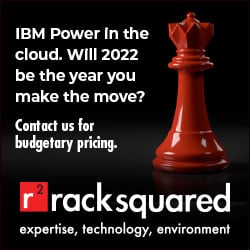
Purchase hardware, depreciate hardware, and repeat.
After four years on the market, the Power9 processor is in the process of being replaced by the Power10 chip. Whether you are an early adopter of CPUs or a laggard, the challenge for many companies is the timing of the refresh. As leases on the Power9 machines are expiring, companies are struggling with how to bridge the gap between the end of their current Power9 system lease and the release of the Power10 systems. Their typical options include lease renewals, lease buyouts, or purchasing a new Power9 server, but some companies just want to get out of owning and managing hardware and are taking this opportunity to consider a migration to Power Systems in one of a number of clouds.
I will look at each of these options and share some of what I hear on each one.
Lease Renewals
This is probably the most common approach taken by companies since it is the path of least resistance. You have a solution that is working, newer technology is not available, and a renewal doesn’t create another IT project or interruption.
The biggest question is really in deciding on the length of the renewal term. To keep costs down, a three-year lease is your best option, but by the time the lease expires the hardware is likely six years old, which is longer than most companies like to operate on a piece of equipment. When you get your new lease quote, don’t be surprised to find that the new lease costs as much or more than the original lease despite the hardware being three years old. Another “gotcha” can be the software and hardware maintenance fees. During the initial term, these fees are usually included in the purchase price but, with the renewal they become a separate incremental expense. If you haven’t budgeted for these incremental costs, it can put you in a tough spot. We often talk to companies that, due to the cost, have opted out of maintenance which is not something we ever recommend.
Lease Buyouts
Next up is the buyout option. Having leased the equipment for three years and paid off a large share of the cost of the box, it can be tempting to take advantage of a $1 buyout or fair market value (FMV) purchase price. Both of these options put an end to the monthly hardware payments, but not maintenance payments, and are likely less expensive than a lease renewal.
But this approach can lead you down a slippery slope from which it is difficult to recover. You convince management and finance that this box still has life left in it, and it does, but when three years from now it is still working and nothing has gone wrong, how do you convince them it’s time to buy new? This is why Racksquared has helped so many companies with emergency disaster recovery situations related to hardware failures on older hardware. They try to squeeze more life out of old equipment and it eventually catches up to them.
Purchasing A New Power9
This is an interesting option, replacing like with like. You stick with the technology you have been using but refresh it with new hardware. Depending on incentives available from IBM or your reseller, this can be an attractive option. New hardware and a new lease with the maintenance included all at a price that is similar to, or maybe less than, what you have been paying.
Unlike the lease renewal or buyout options, this option is going to require you to perform a migration between boxes. Depending on your level of staffing and expertise this may be a simple inhouse exercise or it may require you to engage a third party to complete the work for you.
Like a lease renewal, if purchase a new box, you will be locked into the Power9 hardware platform for another two to three years. This isn’t necessarily a bad thing just something to keep in mind.
When I spoke to a reseller about what other companies chose to do in 2021, he indicated that IBM didn’t really have a formal program to incent companies to replace like with like and thus few opted for the Power9 to Power9 replacement option. With entry and midrange Power10 machines coming this year, perhaps in May or June, IBM is very unlikely to be giving great deals on Power9 systems.
IBM Power In The Cloud
Going back to that company that “just wants to get out of the hardware business,” this is a great time to consider migrating to the cloud. With a cloud migration, you put an end to the buy hardware, depreciate hardware cycle, you gain access to a defined hardware migration path, and you put an end to installing PTFs and doing OS upgrades. With the cloud option, you move your applications to a Power9 server that is owned and managed by a cloud service provider and work with them to migrate to the Power10 machines when they are available and you are ready.
Many people have the perception that a cloud service will be more expensive, but often before you dismiss it, do a deep dive into the pricing and what you get. We often find companies that have purchased a box with the minimum standard configuration that are only using a fraction of the resources. With a cloud service provider, you can have the resources “right sized” for your needs and only pay for what you use. This can lead to cost savings that you may not have anticipated. Another factor to consider when doing a cost comparison is understanding the full scope of the services you will be receiving. With our cloud-based IBM Power Systems offering, customers get the benefit of a comprehensive backup solution that puts their data in multiple data centers and the option to deploy disaster recovery solutions to meet or beat their recovery time objective and recovery point objective. These added benefits and options create business resiliency that their on premises setups can’t match.
Learn More
If you would like to explore options for migrating to a cloud based solution, check out our IBM Power Solutions on the web, see some of our client success stories or contact us to schedule a call.

